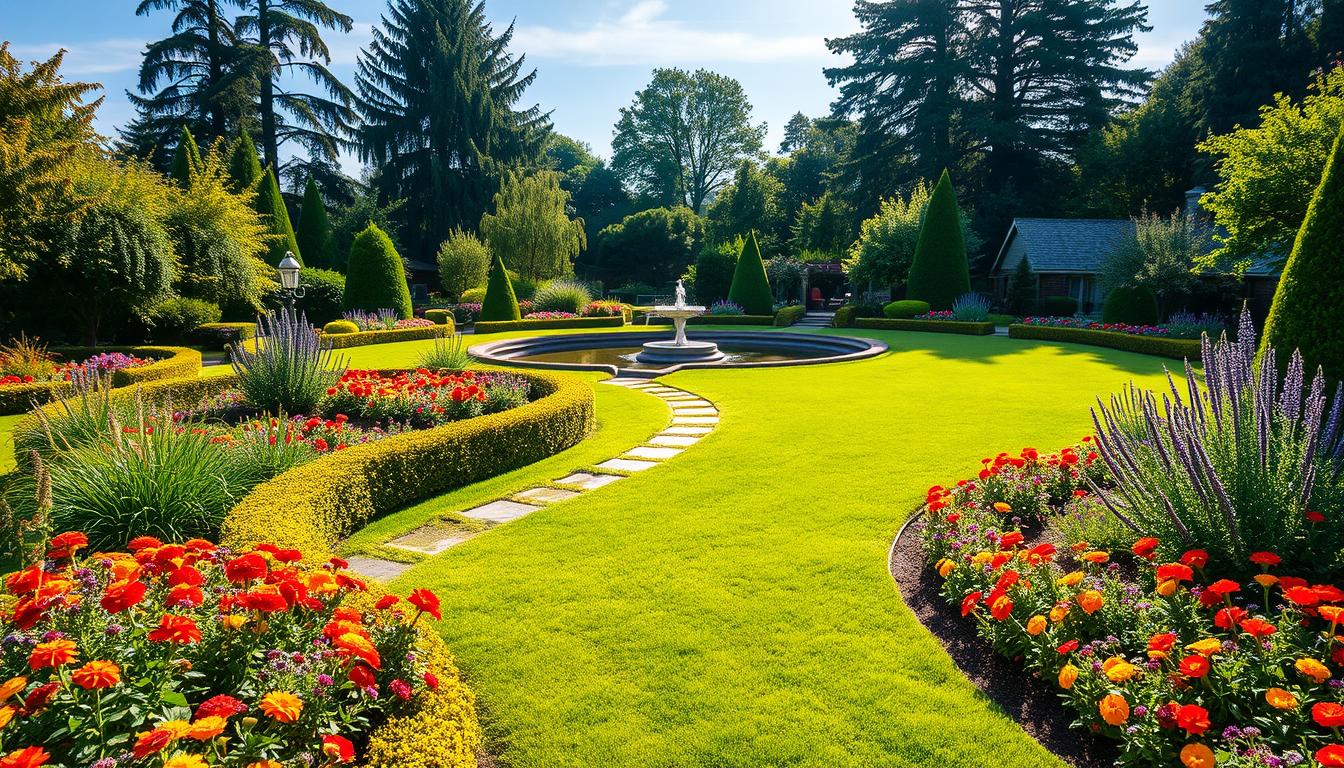Transforming your yard into a vibrant, eco-friendly space is a growing trend. By blending functional areas with natural beauty, you can create a space that’s both practical and stunning. Whether you have a small patch or a sprawling area, there are endless possibilities to explore.
This guide offers 11 creative ideas to help you reimagine underutilized spaces. From low-maintenance designs to plant selections that thrive in various conditions, these tips cater to all yard sizes. You’ll also discover how these changes can reduce upkeep, boost biodiversity, and even provide fresh produce.
Starting small and expanding over time is a smart approach. Real-world examples show how adaptable these ideas are, making them perfect for any yard. Dive into planning tips, plant recommendations, and design strategies to create a space you’ll love.
Key Takeaways
- Blend functionality with natural beauty for an eco-friendly yard.
- Explore 11 creative ideas to transform underutilized spaces.
- Enjoy benefits like reduced maintenance and increased biodiversity.
- Start small and expand your landscaping efforts over time.
- Adapt ideas to fit any yard size or condition.
Why Transform Your Lawn into a Garden?
Revamping your outdoor space can bring both beauty and practicality to your home. By converting part of your lawn into a garden, you can enjoy numerous benefits while contributing to a healthier environment. This approach not only enhances your property’s appeal but also supports sustainability.
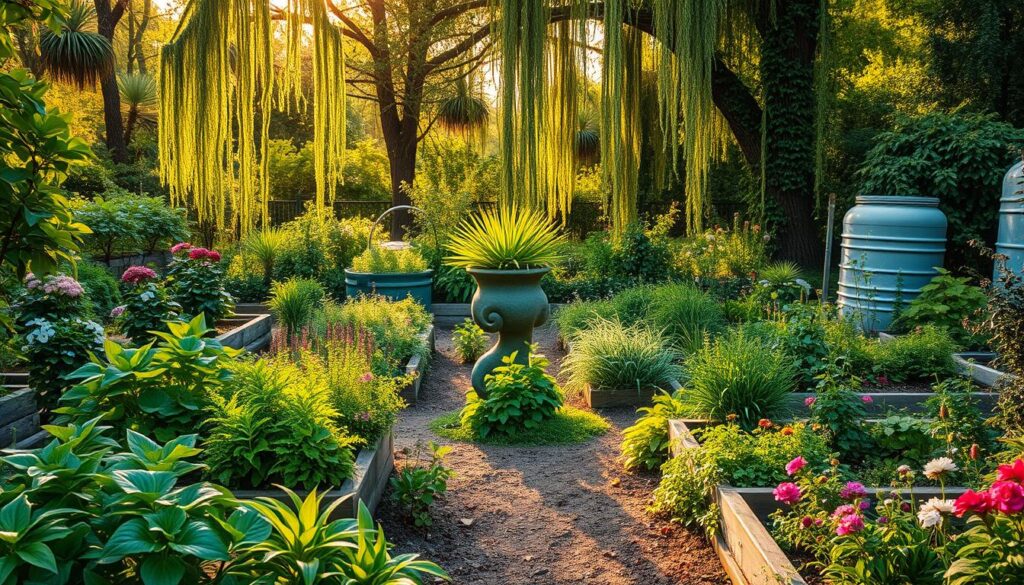
Benefits of a Garden with Lawn
Switching to a mixed garden and lawn setup can save you money and time. On average, maintaining a traditional lawn costs around $3,000 annually. In contrast, a perennial garden reduces expenses significantly while requiring less upkeep.
Water efficiency is another advantage. Mixed gardens use 30-50% less water than pure turf, making them ideal for drought-prone areas. Additionally, native plants attract pollinators, supporting four times more bee species than conventional lawns.
Homeowners often notice increased curb appeal and wildlife activity. One gardener shared, “After converting half my lawn, I received compliments from neighbors and spotted more birds and butterflies.”
Eco-Friendly Landscaping
Eco-friendly gardening practices can reduce your carbon footprint. For example, growing your own food saves energy. Producing one pound of tomatoes at home prevents 0.5 pounds of CO2 emissions compared to store-bought options.
According to the EPA, converting even a portion of the 40 million acres of U.S. lawns could support vital ecosystems. This shift promotes biodiversity and helps combat climate change.
| Feature | Traditional Lawn | Perennial Garden |
|---|---|---|
| Annual Cost | $3,000 | $1,200 |
| Water Usage | High | 30-50% Less |
| Pollinator Support | Low | High |
Planning Your Garden with Lawn
Creating a balanced outdoor space starts with thoughtful planning. Before diving into design, assess your area to understand its potential. This step ensures your project aligns with your goals and the natural features of your yard.
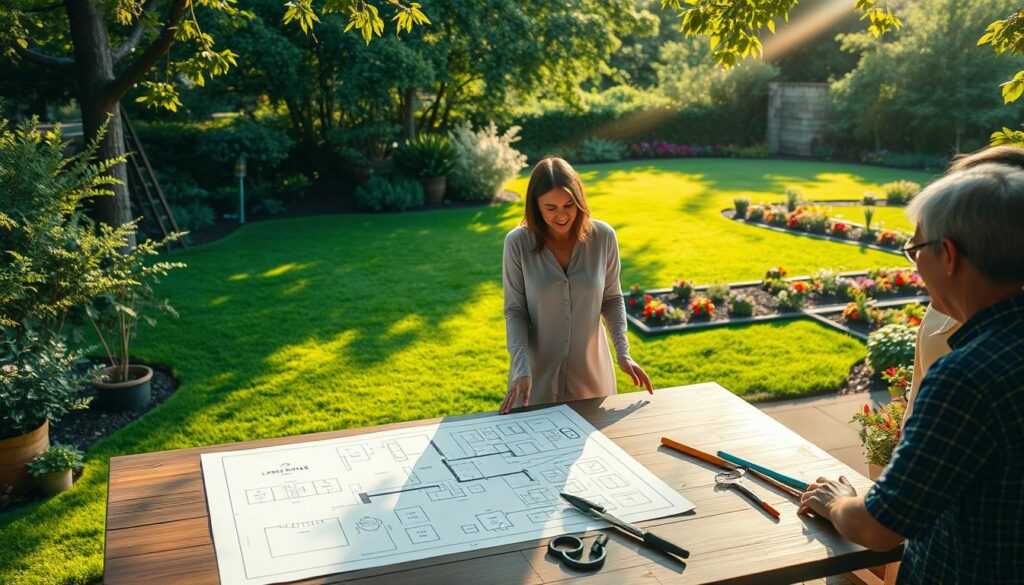
Assessing Your Space
Begin by mapping the sunlight in your area. South-facing spots typically receive 6-8 hours of sun, ideal for edibles. Use free apps like Sun Seeker to track sun patterns throughout the day.
Next, test your soil. DIY kits ($20-50) are a budget-friendly option, but professional lab analysis provides detailed insights. Knowing your soil composition helps you choose the right plants and amendments.
Consider microclimate factors too. Windbreaks, like ornamental grasses or low hedges, can protect plants from harsh winds. Slope considerations are also crucial. For grades over 15%, terracing can create usable planting areas.
Choosing the Right Location
Selecting the perfect spot depends on your goals. For a productive space, prioritize areas with ample sunlight. An 8’x10′ front yard garden, for example, can yield 100 lbs of seasonal veggies.
If you have pets, designate play zones with urine-resistant grasses. This keeps your design pet-friendly while protecting plants. PVC pipes or rebar can help create precise curved bed layouts, even in small yards.
By evaluating these factors, you’ll create a functional and beautiful outdoor area tailored to your needs.
Types of Gardens to Consider
Exploring different types of outdoor spaces can unlock endless possibilities for your home. Whether you’re looking to grow fresh produce, support local wildlife, or create a serene retreat, there’s a design to match your vision. Below, we’ll dive into three popular options to inspire your next project.
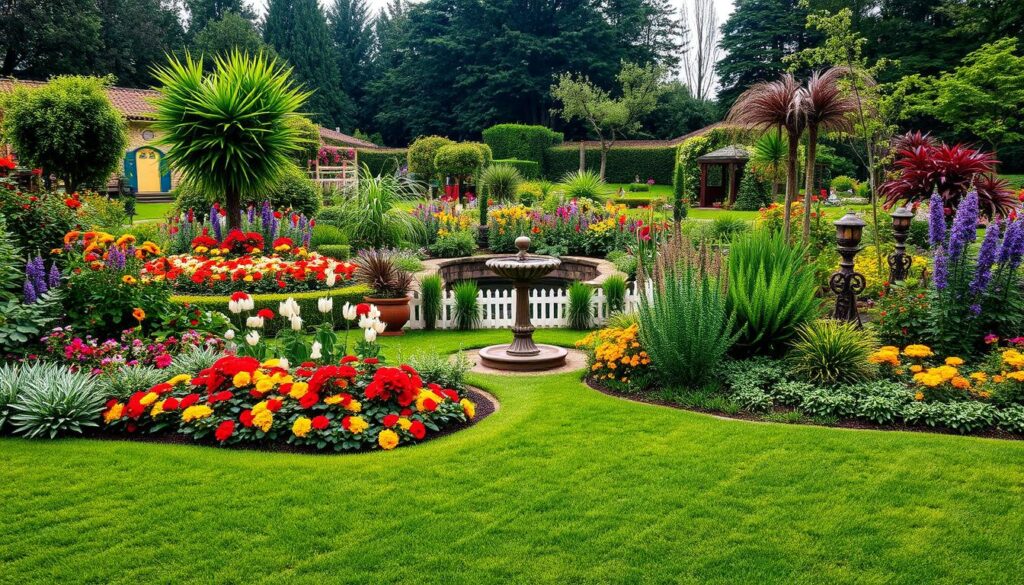
Edible Gardens
An edible garden is perfect for those who want fresh, homegrown ingredients. Start with beginner-friendly veggies like cherry tomatoes, zucchini, and basil. These plants thrive in a sunny garden bed and can yield a harvest in as little as 90 days.
For smaller spaces, consider container gardening. Repurpose old wheelbarrows or pots to create mobile herb planters. This approach is ideal for a front yard or patio, making it easy to grow your own food even in limited areas.
Native Plant Gardens
Native plant gardens are low-maintenance and eco-friendly. These plants are adapted to local conditions, requiring less water and care. A Minnesota couple transformed their space into a prairie garden, reducing mowing by 80% while supporting local wildlife.
Incorporate species like Tuscan kale and penstemon ‘Blue Springs’ for a vibrant, sustainable landscape. Native gardens are perfect for those looking to create a resilient and beautiful outdoor area.
Butterfly Gardens
Butterfly gardens are a haven for pollinators. To create a monarch waystation, include at least 10 milkweed plants and nectar sources. These perennials attract butterflies while adding color to your space.
Design your garden to bloom throughout the season, ensuring a steady food supply for pollinators. Add sensory elements like lamb’s ear for texture and honeysuckle for fragrance to enhance the experience.
Preparing Your Lawn for Transformation
Ready to give your outdoor space a fresh start? Preparing your lawn for transformation is the first step. Proper groundwork ensures your project is successful and sustainable. From removing unwanted grass to enriching the soil, these steps set the stage for a thriving space.
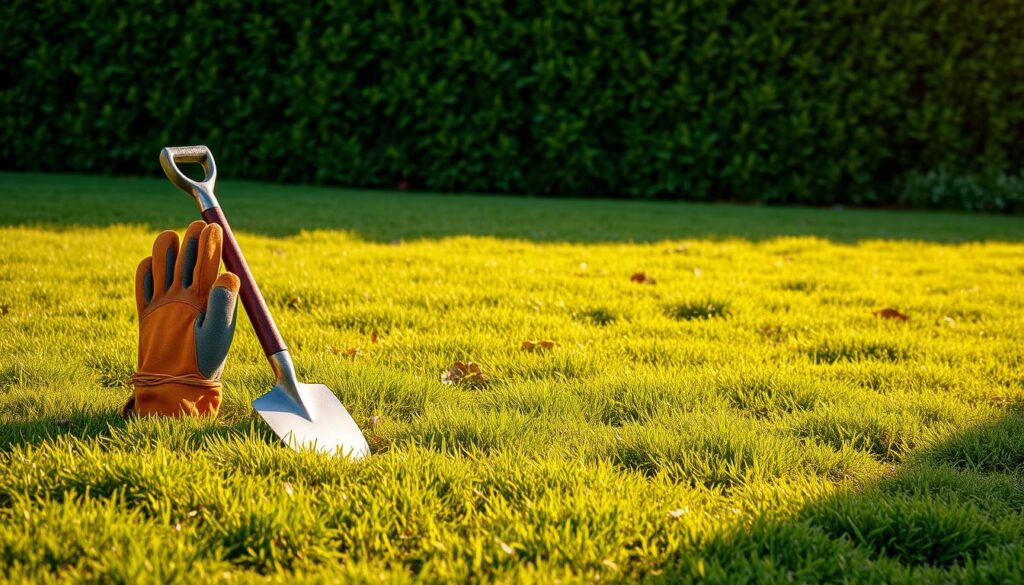
Removing Grass: Methods and Tips
Removing grass is essential for creating a clean slate. There are several methods to choose from, each with its own benefits. Solarization, for example, takes 4-12 weeks but is eco-friendly. Layering cardboard and mulch is another effective technique, though dyed mulch may reduce earthworm activity.
Here’s a quick comparison of popular methods:
| Method | Cost | Timeline |
|---|---|---|
| Sod Cutting | $75/day (tool rental) | 1-2 days |
| Smothering | $50 (materials) | 4-6 weeks |
| Lasagna Gardening | $30 (materials) | 8-12 weeks |
Soil Testing and Amendment
Healthy soil is the foundation of any successful project. Start with a DIY test to check composition and pH. A jar sedimentation test reveals sand, silt, and clay ratios. For pH, mix vinegar or baking soda with soil to see if it fizzes.
Once you know your soil’s needs, amendments can improve its quality. For every 100 sq ft, mix 3 cubic yards of compost and 5 lbs of bone meal. This boosts nutrients and promotes plant growth.
Pro Tip: Before digging, call 811 to locate underground utilities. Wait times vary by state, so schedule this at least two weeks before starting your project.
Designing Your Garden Layout
Crafting a functional and visually appealing outdoor area begins with thoughtful design. A well-planned layout ensures your space is both beautiful and practical. Whether you’re working with a small patch or a larger area, the right approach can make all the difference.
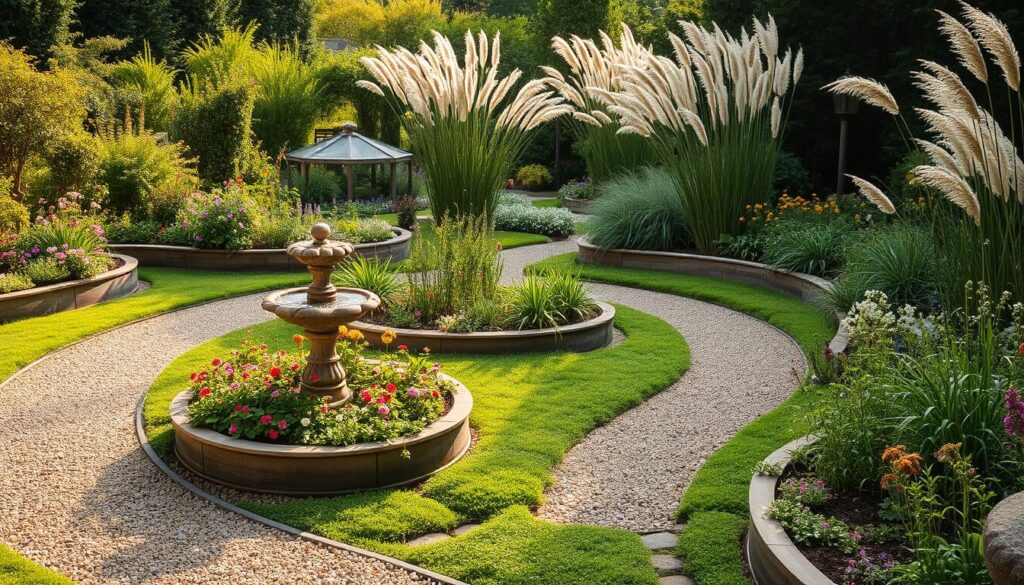
Creating Garden Beds
Raised beds are a popular choice for their accessibility and versatility. Optimal dimensions of 4’W x 8’L x 12”H make them easy to maintain and harvest. Use untreated wood or stone to frame your beds for a natural look.
Companion planting can maximize space and improve plant health. Pair tomatoes with basil, carrots with onions, or corn with beans for a thriving setup. For vertical gardening, trellises are ideal for cucumbers and pole beans, adding height and visual interest.
ADA-compliant designs ensure inclusivity. Keep pathways at least 36” wide and provide 18” of knee space under beds for wheelchair access. These features make your space welcoming for everyone.
Incorporating Pathways
Pathways add structure and charm to your outdoor area. Materials like decomposed granite ($0.50/sq ft) offer affordability, while flagstone ($8/sq ft) provides durability and elegance. Choose based on your budget and style.
For a rustic touch, consider honey-locust log stepping stones. They blend seamlessly into the landscape while offering functional charm. Gravel paths, especially 3’ wide ones using dark gray pebbles, create a clean and modern look.
Well-designed pathways not only guide movement but also enhance the overall design of your space. They connect different areas, making your outdoor area cohesive and inviting.
For more inspiration on outdoor decor, check out these boho yard decor ideas to complement your layout.
Choosing the Right Plants
The key to a vibrant landscape lies in choosing plants that suit your space and climate. Whether you’re looking for low-maintenance options or seasonal blooms, the right selection can make all the difference. Start by understanding your zone and the specific needs of your outdoor area.
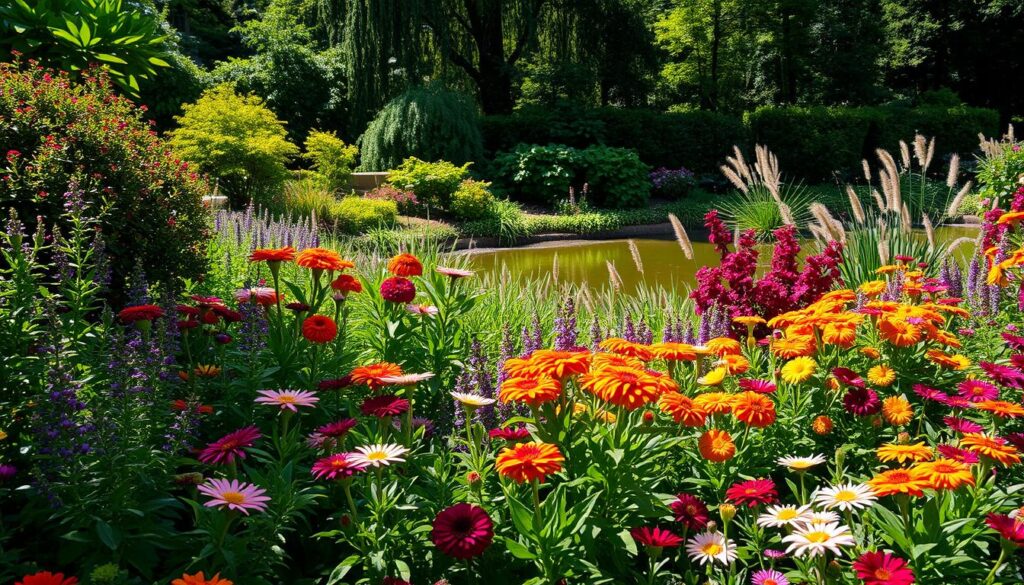
Selecting Perennials and Annuals
Perennials are a great choice for long-term beauty. Purple coneflower thrives in zones 3-9, while citrus trees are ideal for zones 9-11. These plants return year after year, reducing the need for replanting.
Annuals, like marigolds and petunias, add vibrant flowers for a single season. They’re perfect for filling gaps or adding quick color. Combining both types ensures a dynamic and ever-changing landscape.
Plants for Different Seasons
To maintain interest throughout the year, choose plants that shine in every season. Winterberry holly adds a pop of color in winter, while hellebores bloom in early spring. Ornamental cabbage provides texture and color in fall.
For a succession planting schedule, start with spring peas, transition to summer peppers, and finish with fall kale. This approach keeps your space productive and visually appealing year-round.
Maintaining Your Garden with Lawn
Keeping your outdoor area thriving requires consistent care and attention. Proper practices ensure your space remains healthy and beautiful throughout the year. From efficient watering to seasonal upkeep, these tips will help you maintain a vibrant landscape.
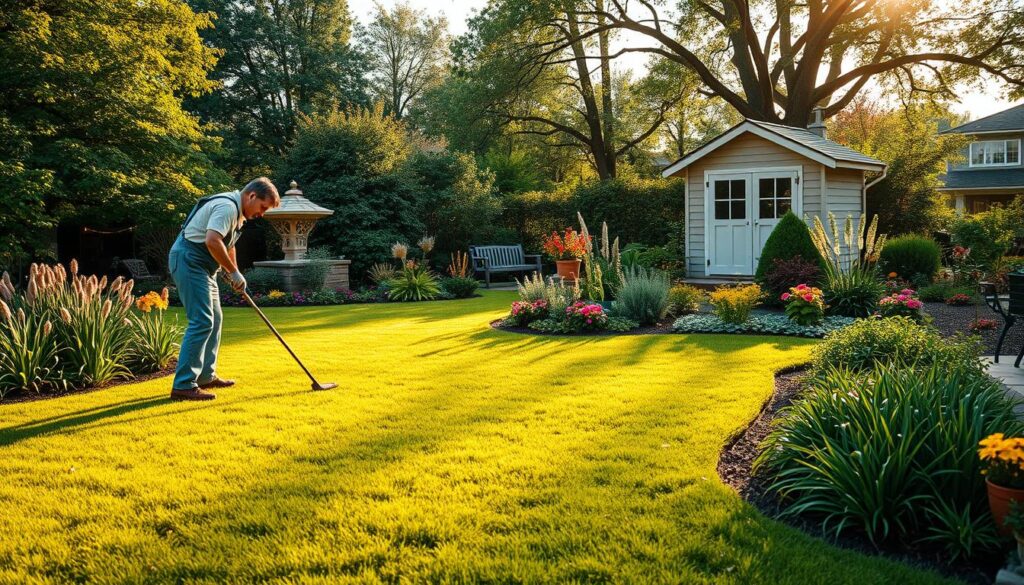
Watering and Mulching Tips
Smart irrigation systems, like the Rachio controller, can save up to 30% on water usage by adjusting to weather conditions. Drip irrigation is another eco-friendly option, delivering water directly to plant roots.
Mulching is essential for retaining moisture and regulating soil temperature. Apply 2-3 inches of organic mulch, such as straw or hardwood, around plants. Fallen leaves can also serve as natural mulch, enriching the soil as they decompose.
Seasonal Care and Maintenance
Each season brings unique tasks to keep your space in top shape. In spring, focus on pruning and preparing beds. Summer requires pest patrol and regular watering. Fall is ideal for planting bulbs and cleaning up debris.
Don’t forget tool maintenance. Sharpen shears at a 20° angle and oil wooden handles annually. A well-maintained toolkit makes seasonal tasks easier and more efficient.
Conclusion
Transforming your outdoor area into a thriving ecosystem is a rewarding journey. From removing grass to enjoying your first harvest, each step brings you closer to a sustainable landscape. Start small—a 4×4’ bed can yield $600 worth of organic produce in a year.
Over time, these changes can increase your property value by 15%. Share your progress using #LawnToGardenChallenge to inspire others. Don’t forget to document your journey with monthly photos to track the recovery of your local ecosystem.
Every effort counts. Begin today and watch your space flourish!

